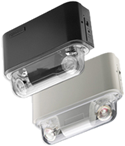|
Since 2004 Champlain Fire Protection has been providing high quality services and emergency products throughout the region of Prescott-Russell and beyond. We also provide live onsite fire extinguisher training with our Laser Driven Extinguisher Training.
Below is the services and products we provide, contact us for all your fire protection needs! |
Contact Us
Louis Turcotte
champlainfireprotection@hotmail.com
613-678-3480
45 Union St. Vankleek Hill ON K0B 1R0
Google Map
Please call to make an appointment |
Services we provide |
-
Onsite Fire extinguisher refill, maintenance & installation
- Certified Hydrostatic Testing for both
SCBA and Scuba tanks
Transport Canada Registered
-
Eddy Current thread laser inspection of all aluminum and graphite tanks, up to 3 feet tall
- SCBA Tank refill
- CO2 refill
- Laser driven fire extinguisher training
-
Testing of emergency lights
-
Kitchen suppression systems inspection
|
|
Products we carry |
Strike First Fire extinguisher
We carry all sizes |
Lumicell Emergency Lights |
Lumicell Exit Lights |
|

|

*Has to be installed by an electrician |
|
Do You Know... |
What is the PASS SYSTEM? |
Having to use a fire-extinguisher is simple in and of itself; However, the situation that requires it's use can make a simple thing difficult of course. When it come to using a fire-extinguisher just remember the acronym P.A.S.S. to help make sure you use it properly.
P.A.S.S. stands for Pull Aim Squeeze Sweep. You certainly learned it at one time or another in school. Once learned it is hard to forget, but, a simple review is always good as with anything learned. To operate a fire-extinguisher properly:
Pull- The first step is to pull the pin ( it usually has the inspection tag attached to it) that prevents the handle from being squeezed.
Aim- The second step is to aim the spray nozzle, or if attached the hose nozzle, at the fire. Aim low at the base of the fire.
Squeeze- The third step is to squeeze the handle to spray the contents. Remember a standard fire-extinguisher has less than 30 seconds of spray time.
Sweep- The final step is to sweep back and forth as you spray the base of the fire.
A fire extinguisher is only to be used for small fires. As a rule call 911 or have someone call before you attempt to put out a fire. Even if you manage to put out a small fire yourself call the fire department to have them come check it out. |
| |
When & how to inspect a fire extinguisher? |
Inspect fire extinguishers at least once a month (more often in severe environments).
Fire extinguisher maintenance is important for everyone’s safety.
You must ensure that:
- The extinguisher is not blocked by equipment, coats or other objects that could interfere with access in an emergency.
- The pressure is at the recommended level. On extinguishers equipped with a gauge (such as that shown on the right), the needle should be in the green zone - not too high and not too low.
- The nozzle or other parts are not hindered in any way.
- The pin and tamper seal (if it has one) are intact.
- There are no dents, leaks, rust, chemical deposits and/or other signs of abuse/wear. Wipe off any corrosive chemicals, oil, gunk etc. that may have deposited on the extinguisher.
|
| |
What is the difference between a fire extinguisher inspection and fire extinguisher maintenance? |
INSPECTION
An inspection is a “quick check” to give reasonable assurance that a fire extinguisher is available, fully charged and operable. The value of an inspection lies in the frequency, regularity, and thoroughness with which it is conducted. The frequency will vary from hourly to monthly, based on the needs of the situation. Inspections should always be conducted when extinguishers are initially placed in service and thereafter at approximately 30-day intervals.
MAINTENANCE
Fire extinguishers should be maintained at regular intervals (at least once a year), or when specifically indicated by an inspection. Maintenance is a “thorough check” of the extinguisher. It is intended to give maximum assurance that an extinguisher will operate effectively and safely. It includes a thorough examination and any necessary repair, recharging or replacement. It will normally reveal the need for hydrostatic testing of an extinguisher. |
|
|
|

